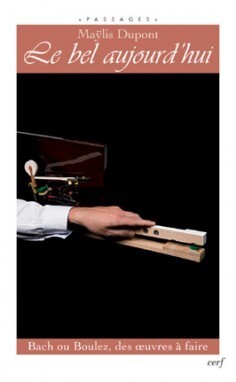De Bach à Boulez : trois siècles de musique, trois siècles de créations, de reprises, de disparitions, longue traîne du présent, de toutes les œuvres présentes. " Musics for piano " de John Cage, " Sonates " de Mozart, " Symphonie fantastique " de Berlioz, " Concerts royaux " de Couperin, " Saint François d'Assise " de Messiaen... Comment rendre compte de ces œuvres ? Qu'est-ce qui fait l'œuvre et sa valeur, en musique ? On connaît deux manières de répondre à la question, disons deux paradigmes de l'œuvre d'art. Paradigme musicologique : l'œuvre, c'est la partition ou le texte musical fixé sur un support (papier, bande, etc.). Paradigme sociologique : l'œuvre, c'est ce que des acteurs, critiques, publics, agents, institutions, etc., désignent comme telle. Où compte avant tout l'" intention esthétique ". L'auteur revient sur l'un et l'autre, pointant les maillons forts et les maillons faibles de ces schèmes de pensée, et leur complicité dans le projet d'arrêter l'œuvre d'art (à l'un de ses supports, à l'une de ses manifestations ou à telle explication). " L'art arrêté ! " Tel pourrait être le bandeau de nombre d'ouvrages sur le thème. Invite à ne pas les approcher ! À l'intellectuel déçu par les sillons fermés de la pensée, au mélomane perdu devant la schématisation de ce qu'il aimait, proposons un autre chemin... Suivons une œuvre " en liberté " ; décrivons ses manifestations (en concert, chez un disquaire, dans des conversations, des articles de presse, etc.), repérées par ce nom : Sur " Incises " de Pierre Boulez ; saisissons, plutôt qu'une œuvre, " ce et ceux qui œuvrent " et alimentent aujourd'hui notre passion. -- From Bach to Boulez : three centuries of music, three centuries of creation, repetitions, disappearances, the long succession leading to the present, to all present works. Music for piano by John Cage, Sonatas by Mozart, Symphonie fantastique by Berlioz, Concerts royaux by Couperin, Saint François d'Assise by Messiaen... How can we talk about these works? What makes the value of a musical creation? There are two ways to answer that question, or we might say two paradigms of the artwork. The musicological paradigm: the work is the score, or the musical text, fixed on a support (paper, tape, etc.). The sociological paradigm: a work of art is what the players, critics, public, agents and institutions describe as being so. What counts above all is the "aesthetic intention'. The author discusses both of these concepts, defining the strong and weak points of their schematic logic and their role in the plan to limit the work of art (to one of its supports, one of its manifestations or to such and such an explanation). "Art within limits!' These words might be written on the belly bands around so many books on the subject. To the intellectual disappointed by closed avenues of thought, to music-lovers who feel lost when the thing they love is schematized, let us present an alternative path... where one may follow a work in total freedom, describe its manifestations (in a concert, a record store, in conversations, the press, etc.). Rather than attempting to grasp a work itself, let us grasp what and who is operating, and in so doing, nourish our passion.




